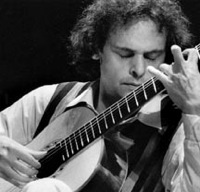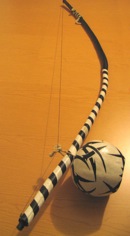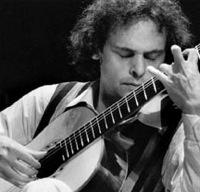
Dyens is an idiosyncratic artist. He never announces a program in advance, preferring to let the music he plays be determined by the spirit of each event. He begins each recital with an improvisation meant to test the acoustics of the hall and the emotional connection he is able to achieve with the audience. On Friday, he began with a compelling improvisation of about five minutes that explored harmony, texture, and various idioms in a manner reminiscent of Keith Jarrett, while being thoroughly idiomatic to the guitar. About two thirds of the way through, he played a direct quotation from George Gershwin’s Rhapsody in Blue, artfully combined with the ostinato from Leo Brouwer’s Elogia de la Danza, which brought smiles to the faces of many in the audience.
Dyens is best known as a composer who draws on a wide knowledge of jazz, classical, French, Brazilian, African, and even Indian styles and creates guitaristic music that blends these interests into unique and personal statements. Angel’s Waltz, dedicated to his longtime manager Russ De Angelo, is an intimate portrait of a friendship. Songe Capricorne is a moody exploration of the key of B minor, featuring elaborate arpeggios, finely calibrated articulations, and intricate combinations of stopped and open strings, which builds to a violent climax before a graceful return.
Dyens used this as an introduction to his arrangement of Chopin’s Waltz in B Minor, Op. 69, No. 2. The guitar can be the most intimate of instruments, and Dyens perfectly captured the atmosphere of 19th-century Parisian salons, which were Chopin’s preferred venues, in a performance notable for its refinement and elegance. A later performance of Fernando Sor’s Introduction and Variations on “Marlborough sen va-t-en Guerre” gave further evidence of Dyens’ mastery of 19th-century music.
From Brazil, With Wit and Drive
The 50th anniversary of the death of the great Brazilian composer Heitor Villa-Lobos (1887–1959) was memorialized with performances of the Aria From Bachianas Brasileiras No. 5, Preludes Nos. 2 and 4, and Chôro No. 1. Villa-Lobos acknowledged the inspiration for his famous aria, written for soprano and eight cellos, in an arrangement for soprano and guitar. Dyens’ exponentially more difficult arrangement of the same music for solo guitar made very effective use of pizzicato and the use of flesh rather than nail with the right-hand thumb to create a beautiful tonal contrast with the singing legato line that he played on higher strings with his fingers.
Dyens’ performance of Prelude No. 2: Homage to the Hustlers of Rio was witty and passionate in turn. His performance of Prelude No. 4: Homage to the Brazilian Indian, though it was marred by some eccentric phrasing in the middle section, ultimately evoked the sense of mystery that Villa-Lobos must have felt when first encountering the indigenous people of the Amazon rain forest. The performance of Chôro No. 1 began as a stylish account that perfectly captured the rhythmic drive of this Brazilian form, first made popular at the turn of the 20th century. Gradually, Dyens began to improvise glissandos, harmonics, and ornamentation, which highlighted the colloquial, popular origins of the chôro and served as a perfect introduction to his arrangements of the music of Pixinguinha.
A composer, conductor, flautist, saxophonist, and bandleader, Pixinguinha wrote his music for ensembles that have frequently been compared to the contemporaneous jazz groups that were performing in the U.S. Dyens’ arrangements of this complex music for solo guitar are stylish, beautiful ... and breathtaking. The care he takes to balance individual lines in a complex web, the individual tone color and articulation he uses to differentiate them, and the almost telepathic connection to the spirit of the original performances — all make for a revelatory listening experience.
Atencioso (Attention) is a classic chôro full of lively energy and playful syncopation, perhaps portraying the joys of courtship. Lamentos (Regrets) has a long, breathed melody suspended over a jazzy, chordal accompaniment and feels more bemused than sad. Rosa, beginning with a gorgeous melody in harmonics, is a heartfelt love song. Um a Zero (One to nothing) captures the exhilaration of a soccer game, with intricate harmonic progressions and an exuberant melody. Carinhosa (Affection), controversial when first written, has become one of Pixinguinha’s most recorded pieces due to its exquisite harmonies and heartfelt portrayal of his love for his wife.
The berimbau is a single-string Brazilian percussion instrument of African origins that was memorialized in a composition by Baden Powell. The arrangement by Dyens of Berimbau for solo guitar was a tour de force for percussion and extended techniques that was a world away from his elegant classical settings of the Pixinguinha, yet related to that music by its references to Brazil. It was a pure delight.

